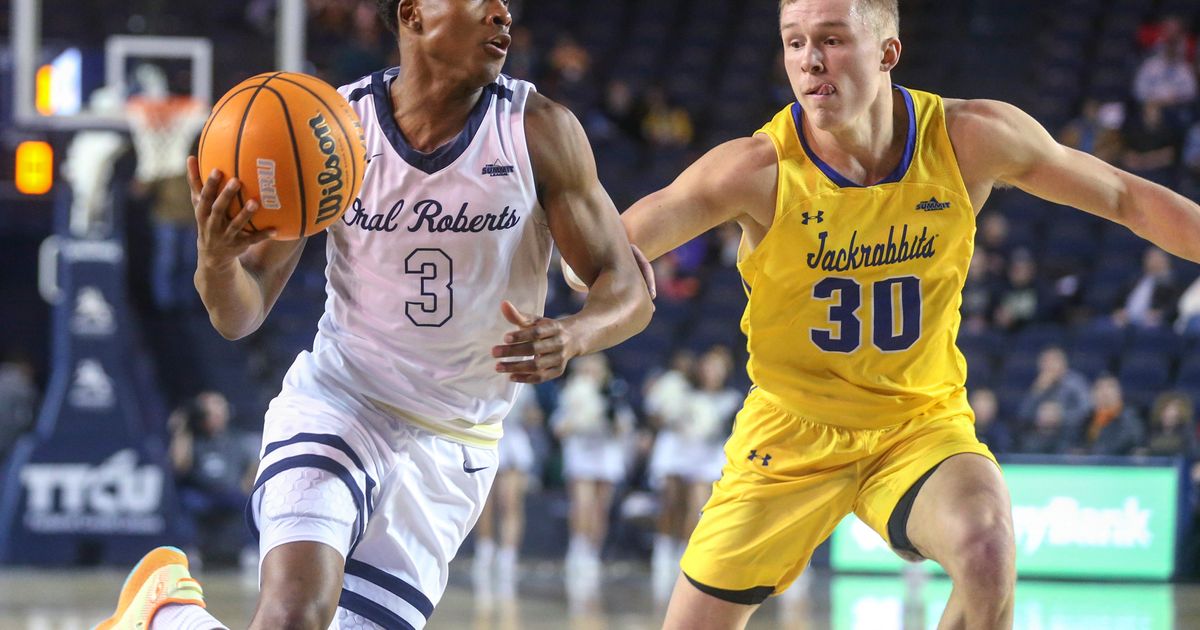
Max Abmas of Oral Roberts won the NCAA scoring title as a sophomore, averaging 24.5 points and he helped his team become just the second No. 15 seed in history to reach the Sweet 16.
He’s been among the national scoring leaders the last two seasons as well, with his 22-point average this year near the top of Division I.
His resume, like those of several top players in the college ranks this season, looks great. But is it NBA worthy? That’s where the Rockwell, Texas, native has much proving to do, and he’s not alone. A number of players with eye-catching numbers may or may not move on to the top league in the world.
At just 6 feet tall and 175 pounds, Abmas would be among the smallest guards in the NBA, so showing he can defend as well as score will be a necessity.
“The size aspect can make me an underdog for sure, but that’s kind of something that I’ve dealt with my whole life, even coming out of high school and not being really highly recruited,” Abmas said. “A lot of coaches probably thought that I was too small.”
How it shakes out could force Abmas to execute Plan B: He is getting a degree in biomedical engineering with designs on pursuing a career in forensics after his playing career.
JAKE STEPHENS, 7-0, 275, Chattanooga
A four-year starter at VMI, this graduate student stands apart from other bigs on draft boards because he is an “unbelievable shooter” from 3-point range, according to Ryan Blake, director of scouting for the NBA. Stephens has made 42 3s this season on 41% shooting, and he also averages 2.35 blocks and 10.2 rebounds.
“The problem is he’s not that mobile,” Blake said, which could make teams concerned that he wouldn’t be able to hold his own against athletic big men on the defensive end. “He’s so smart and he can pass the ball. If he had really good athleticism, he’d be a lottery pick.”
DREW TIMME, 6-10, 235, Gonzaga
An AP All-American the past two seasons, Timme has been a major reason why No. 12 Gonzaga has lived near the top of the rankings. He averages 21.4 points and shoots 61%, but doesn’t shoot many 3s (2 of 18) and is not a dominant rebounder (7.5 rpg) even in the mediocre West Coast Conference.
What he does have, though, is a high basketball IQ and a knack for stepping up at crunch time.
“You look take a circle graph and you chart all those things,” Blake said. “The guy knows how to play. He can score. He can defend, but can he defend on the next level? Can he defend against stronger and quicker players? Those are going to be the questions that have to be answered and that’s probably why he hasn’t left yet.”
Timme’s endorsement earning are thought to be at least close to the $200,000-$500,000 NBA rookies can earn on two-way contracts.
Timme could return to the Zags again next season thanks to the NCAA giving every player from the COVID-19 years an option for an extra year. His projected position in the draft could be key because contracts for first-round picks are guaranteed; second-round contracts are not.
ANTOINE DAVIS, 6-1, 165, Detroit Mercy
This season’s NCAA scoring leader (26 per game) broke Fletcher Magee of Wofford’s Division I record of 509 career 3-pointers, and then broke John Grotberg of Grinnell’s all-division mark of 526.
As of Wednesday, Davis has 534 3s and stands second on the NCAA scoring list with 3,332 career points, second to Pete Maravich of LSU (3,667).
Maravich set his mark in just three seasons: Davis is in his fifth year with at least nine games left and would need to average more than 37 points to catch Maravich.
“He can shoot. He can score. He’s a coach’s son. A lot of qualities,” Blake said of the 6-1 son of Titans’ coach Mike Davis. “I like the kid. He will be a guy that can be more of a playmaker, distributor, defender.”
Davis seems to have the tools — he and Keydren Clark of Saint Peter’s are the only players in history with 3,000 points and 500 assists.
PROVING GROUND
Blake and his staff invite 64 players to the three-day Portsmouth Invitational in Virginia. Not the can’t-miss players eligible for the draft, the invitees are those who warrant a closer look against better competition.
The four-day, 12-game tournament in April is attended by scouts from the NBA and international leagues. Organizers guarantee that at least five players will then be invited to the NBA’s Chicago combine, where many of the top players in the draft pool compete against each other.
___
AP college basketball: https://apnews.com/hub/college-basketball and https://apnews.com/hub/ap-top-25-college-basketball-poll and https://twitter.com/AP_Top25